HOW TO INSTALL A 600 WATT SOLAR SYSTEM ON THE CHEAP
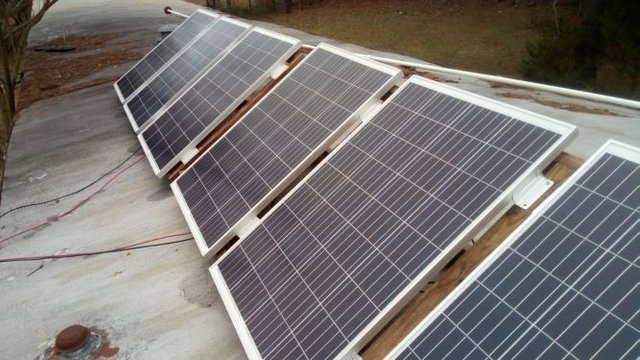
A 600-watt solar system is a small system, but it can be a great place to start. Going off-grid is a journey and you have to start somewhere. This system can cost between $1,500 and $2,000 if you do the install yourself. This article will show you just how to do that.
Some of my articles contain affiliate links. Click here to learn more.
Contents
- What situation this set-up is for.
- How difficult will this be?
- Materials Needed
- Tools Needed
- Step by step process
- Step 1: Build a rack system for the solar panels
- Step 2: Connect the solar panels in parallel
- Step 3: Decide where to store battery bank, charge controller and inverter
- Step 4: Install batteries and wire in parallel
- Step 5: Mount charge controller and inverter
- Step 6: Connect battery bank to charge controller
- Step 7: Connect solar array to charge controller
- Step 8: Connect Inverter to existing A/C breaker box
- Step 9: Connect battery bank to the inverter
- Summary
- Resources (direct links to all the parts used in this article)
What situation this set-up is for
The exact situation for this project is retrofitting solar to an old mobile home that was originally set up for A/C power connected to a public utility grid.
One of my neighbors who lives up on the mountain near us lost their home to fire. They lost everything in the fire but had an old abandoned mobile home on their property. They decided to move into it, but it had no electricity.
They asked me if I could install a solar system on the mobile home and told me they had a budget to buy materials of $2,000.
This article is the result of that project. To be clear, this set-up is not the ideal set-up to do solar, but it is what I came up with to fit their budget and to utilize the existing mobile home.
A very large part of living off-grid is making compromises between what is ideal and what you have to work with, so I thought this would make a great article for Offgridmaker.com.
One very important note: This set-up WILL NOT WORK, if your structure is hooked to the electric grid. If you try to hook a system up like this to a structure currently connected to the power grid you will damage the electrical components of the system.
How difficult will this be?
This project isn’t difficult if you follow along with this step -by step tutorial. I’ll rate this project on a 1 thru 10 scale based on skills you may have. 1 is so easy you can do it in your sleep 10 being you should get professional help.
- If you’re an electrician or work in the electrical field, this project will be a 2.
- If you’re handy with tools, but don’t have electrical experience, this project will be a 4.
- If you have little to no experience with tools, this project will be a 6.
- If you have no tool experience and you don’t know what a circuit breaker is, this project is a 10.
If you would like to take a deeper dive into the basics of solar so you can understand why not just how I recommend the book below. Click the image for the current price and availability on Amazon.
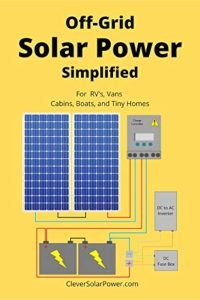
Materials
- 6 – 100-watt solar panels
- 1 – 1500 watt pure sine wave inverter
- 1 – 40 amp PWM charge controller
- 3 – 110 amp/hour 12v deep cycle solar AGM batteries
- 4 – battery connector cables
- 2 pair– 3 to 1 Y MC4 connectors
- 1 pair – 2 to 1 Y MC4 connector
- 12 ga copper stranded wire rated for exterior use (length depends on your own projects)
- 6 – 3/8” washers
- mounting screws (type and size dependent on your application)
- 6 sets of solar panel mounting brackets
Tools
- Screw gun/screwdriver
- 10mm wrench or socket
- #2 Philips head screwdriver
- wire strippers
Step by Step process
Step 1: Build a rack system for the solar panels
I highly recommend having your solar panels attached to a rack of some kind. This allows for more accurate alignment with the sun and makes it less likely the solar panels will be damaged.
That being said, you can temporarily lay the panels on the ground or lean them against a structure to save the cost of a solar panel rack system. This article is about the wiring and connection of a basic solar system so I haven’t included any instructions about the solar panel rack.
I have written a separate article about how to build a solar panel rack for free.
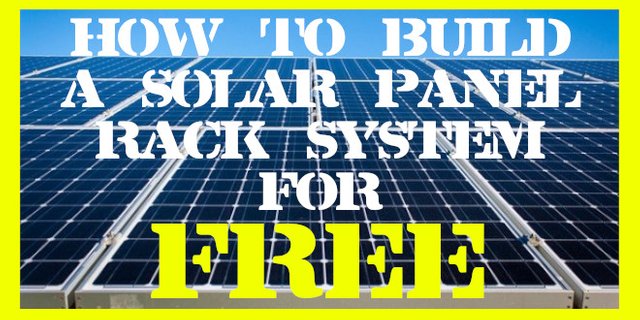
Step 2: Connect the solar panels in parallel
Whether you have installed your solar panels on a rack or not you have to wire the panels in parallel.
Simply put, this means you will connect all the positive wires together and all the negative wires together. Since we have used 6 solar panels the easiest way to do this is to Connect 3 panels together with the 3 to 1 Y MC4 connectors.
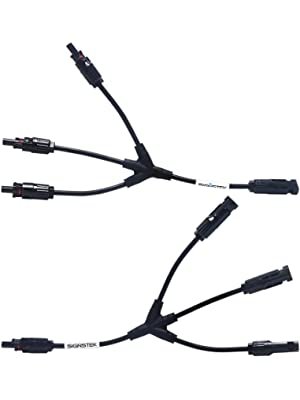
After this is done you should have 2 sets of 3 panels. Now connect the 2 sets of panels together together with the 2 to 1 Y MC4 connectors.
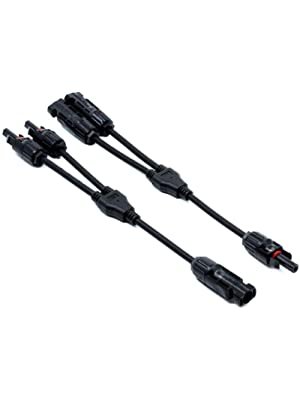
You should now only have 1 pair of wires (1 positive and 1 negative) coming from the panels and ready to run to the charge controller.
Step 3: Decide where to store battery bank, charge controller and inverter
Now you must decide where to install all the components for the system. Ideally, you want all the components installed as close to each other as possible and as close to the solar panels and the existing breaker box as possible.
This does two things. It allows for the purchase of less cable lowering the cost of the project and it creates a system with less efficiency loss which means getting more out of the system.
Ideally, you want your components in a closed area like a closet that you can vent later as the system gets larger, but in a location that is easily accessible.
Because the distances between components are going to be different on your project than it is in this project you will want to check gauges for wiring to make sure you use the correct gauge wires. If the distances from your solar panels to your batteries is less than 30 ft. then you can use the gauges set forth in this tutorial.
Check this link for a solar cable gauge calculator. https://www.renogy.com/calculators
Step 4: Install batteries and connect in parallel
There are different ways to configure a battery bank. For this system we want our battery bank to produce 12 volts. This means connecting the batteries together in a parallel configuration.
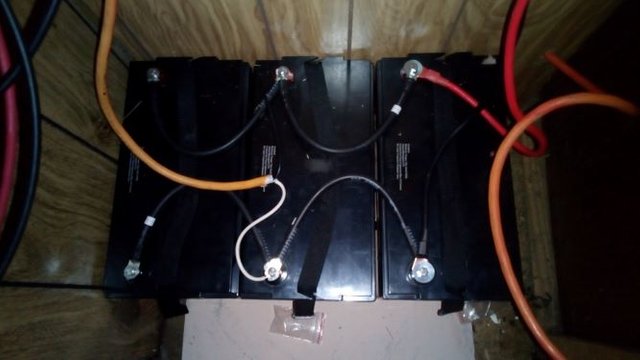 notice the black battery cables are connecting all positive posts together and all negative posts together.
notice the black battery cables are connecting all positive posts together and all negative posts together.You will connect all the positive posts together and all the negative posts together.
For this, you will use the battery connector cables which are heavy gauge and short. This is where you will use the washers. The cable ends will attach to the battery with a washer and battery post bolt. Different types of batteries use different methods for battery post connection, but if you purchased your batteries through the links provided in this article then you can just follow the pictures provided. If you have purchased different style batteries then the main thing is to make sure the batteries are connected in a parallel configuration.
Step 5: Mount charge controller and inverter
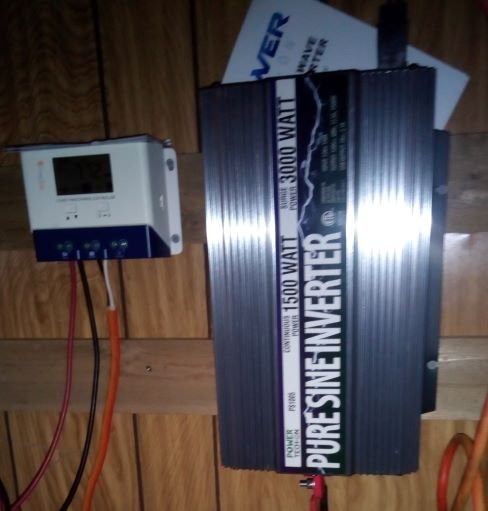 Notice the 1x4s on the wall that the inverter is mounted to.
Notice the 1x4s on the wall that the inverter is mounted to.Now it’s time to mount the charge controller and the inverter. You want them mounted as close to the battery bank and the A/C breaker box as possible while also in a place that can be easily accessed because from time to time you will need to check on the status of the system by looking at the display on the charge controller.
The charge controller is very small and light so it can be easily secured with small screws into wall paneling or using sheetrock anchors if needed.
The inverter is large and heavy so, it will need to be mounted with more attention to stability. In this project, you can see I attached 2 1x4s to the studs of the closet wall and attached the inverter to the 1x4s. The inverter has receptacles and the on/off button on one end, so be sure to install the inverter with that end up for ease of access.
Step 6: Connect battery bank to charge controller
Now you can start connecting all your components together. It is best under most circumstances to connect the battery bank to the charge controller before you connect the solar array to the charge controller, but if you are following this tutorial and have purchased your charge controller through the resource links provided at the end of this article then be sure to connect the battery bank first.
You can connect the battery bank to the charge controller using leftover wire from the solar panel connection cables or you can use a section of an old extension cord. Just make sure the wire you use is at least 12 gauge copper stranded wire. There is a section on the bottom of the charge controller where you make all the necessary connections. There is an icon over each set of connections to let you know what to connect where. You will connect the battery bank to the set of connections indicated by an icon of a battery using one wire for both the positive connection and the negative connection. You only need to connect to one of the batteries in the battery because they are connected together in parallel.
Step 7: Connect solar array to charge controller
It’s time now to connect the solar array to the charge controller. You should have one pair of wires coming into the structure from the solar panel array outside. These wires will connect to the charge controller connections indicated by an icon of a solar panel. Make sure that positive goes to positive and negative to negative. Bringing the solar array wires into the structure can be done in several different ways; through the wall, roof or floor. Just make sure however you choose to make the penetration in the structure that it’s watertight and doesn’t allow for rain to get into the structure.
Step 8: Connect Inverter to existing A/C breaker box
With the battery bank now connected to the charge controller, you can connect the inverter to the A/C breaker box of the structure.
I want to stress again that you can not connect the inverter to an A/C breaker box in this fashion. If the A/C breaker box is connected to an electric utility provider. It can damage or ruin your new solar equipment and it can be very dangerous to you. Make sure the existing breaker box isn’t connected to the utility provider.
If you aren’t sure about this then go no further with this project until you are.
At this point in the system the highest amps will potentially be running, so use the heaviest wire you can. Anything above 8 gauge won’t be necessary on this exact set-up. At one end of the wire, you will need a male receptacle plug the other end will hardwire directly to the input side of the A/C breaker box.
The end with the plug will plug directly into one of the 3 outlets on the inverter. On the other end, you will connect the black wire one pole of the main shut-off breaker in the breaker box. Connect the common wire (white wire) to the common wire bus in the breaker box. The common bus will be on the side of the breaker box and will have several other white wires connected to it. The bare wire, also known as the ground, will be connected to the other bus in the breaker box with other ground wires connected to it.
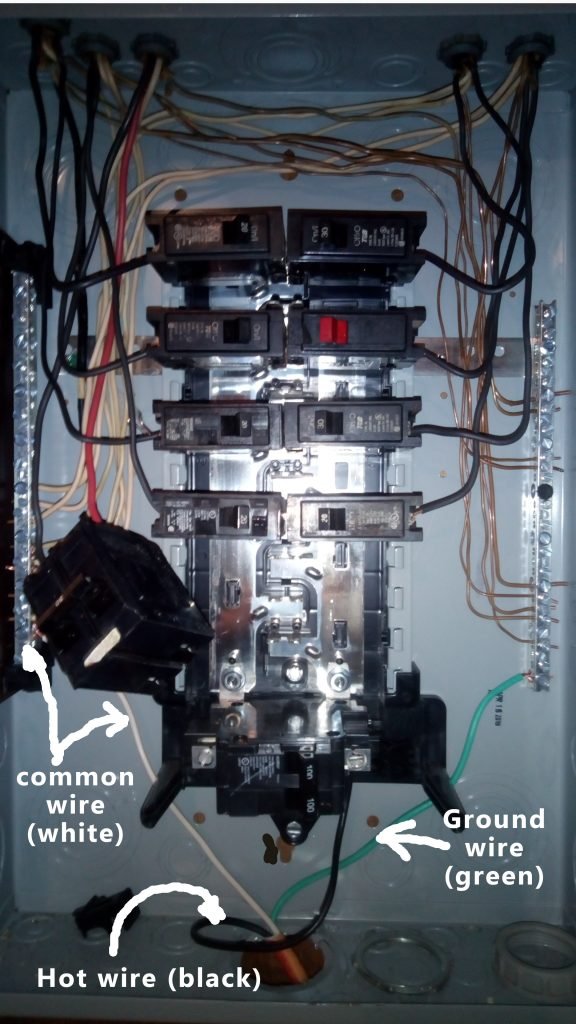
Step 9: Connect battery bank to the inverter
The last connection to be made is connecting the battery bank to the inverter. If you used the links provided in this article to purchase your components then the inverter you purchased will have the cables needed to connect the inverter to the battery included. Connect the red cable to the positive post on one of the batteries and to the red post on the bottom of the inverter. Install the black cable to the negative post of the same battery and to the black post on the bottom of the inverter.
Congratulations, You have now installed a 600watt solar system.
Finally. You will need to plug the remote power switch into the inverter. This power switch has a long cable so you can run it to a convenient place to quickly be able to shut down the inverter which will separate the flow of power from the battery bank to the inverter.
Since we have only run power to one leg of the breaker box only half of the circuits in the breaker box will have power. You can use only these circuits or you can duplicate step 8 and connect it to the other leg of the breaker box. This will allow the use of all the circuits in the breaker box, but it will also increase inefficiency through increased loss due to resistance.
Summary
This system is a barebone type of system meant to get power going with 600 watts of power and a budget under $2000. There are different downfalls to this system that can be improved with a higher budget and would be recommended if a higher budget is possible. Contact me through the contacts if you have questions about what I would change if more money to purchase components where available.
This system is also designed to connect to an A/C breaker box to supply power to a structure. This is a less efficient way to supply power than a D/C system, but there are several different reasons to do it this way. Contact me through the contacts if you have any questions.
Click here to view all the products I used for this project https://offgridmaker.com/resource-page/
HIVE IS ALIVE!!!
JOIN US, YOU'LL HAVE EXACTLY THE SAME BALANCE AS YOU HAVE HERE ON STEEM WITHOUT THE CENTRALIZATION AND CENSORSHIP!!
https://hive.blog